Isolation, Characterization, Antioxidant and Anticancer Activities of Compounds from Erythrina caffra Stem Bark Extract
Abstract
1. Introduction
2. Materials and Methods
2.1. Materials
2.2. Plant Collection
2.3. Sample Extraction
2.4. Antioxidant Study by 2,2-Diphenyl-1-Picrylhydrazyl (DPPH) Assay
2.5. MTT Cytotoxicity Assay
2.6. Acridine Orange/Ethidium Bromide Dual Staining for Apoptosis
2.7. Isolation of Bioactive Fractions of E. caffra and NMR Characterization
2.8. Qualitative Analysis
2.8.1. NMR Characterization
2.8.2. GC–MS Characterization
2.8.3. High-Resolution Mass Spectrometry (HRMS)
2.9. MultiCaspase Analysis
2.10. Statistical Analysis
3. Results
3.1. Antioxidant and Anticancer Activity of Crude Extracts of Erythrina caffra Stem Bark
3.2. Chemical Characterization of Isolated Compounds
3.3. Anticancer Activity of Isolated Bioactive Compounds from Erythrina caffra
4. Discussion
5. Conclusions
Supplementary Materials
Author Contributions
Funding
Institutional Review Board Statement
Informed Consent Statement
Data Availability Statement
Acknowledgments
Conflicts of Interest
Abbreviations
| DPPH | 2,2-diphenyl-1-picrylhydrazyl |
| MTT | 3-(4,5-dimethylthiazol-2-yl)-2,5-diphenyltetrazolium bromide |
| DCM | Dichloromethane |
| MeOH | Methanol |
| HEK293 | Human Embryonic Kidney 293 cells |
| HeLa | Human cervical cancer cell line |
| MCF-7 | Human breast cancer cell line |
| IC50 | Half-maximal inhibitory concentration |
| AO/EB | Acridine Orange/Ethidium Bromide |
| 5FU | 5-Fluorouracil |
| CC | Column Chromatography |
| TLC | Thin-Layer Chromatography |
| NMR | Nuclear Magnetic Resonance |
| 1H NMR | Proton Nuclear Magnetic Resonance |
| 13C NMR | Carbon-13 Nuclear Magnetic Resonance |
| HRMS | High-Resolution Mass Spectrometry |
| HR-ESI-MS | High-Resolution Electrospray Ionization Mass Spectrometry |
| GC–MS | Gas Chromatography–Mass Spectrometry |
| CDCl3 | Deuterated Chloroform |
| PBS | Phosphate-Buffered Saline |
| DMSO | Dimethyl Sulfoxide |
| NAD(P)H | Nicotinamide Adenine Dinucleotide (Phosphate) |
| 7-AAD | 7-Aminoactinomycin D |
| MAPK | Mitogen-Activated Protein Kinase |
| PI3K/Akt | Phosphoinositide 3-Kinase/Protein Kinase B |
References
- Peto, J. Cancer Epidemiology in the Last Century and the next Decade. Nature 2001, 411, 390–395. [Google Scholar] [CrossRef]
- Bray, F.; Laversanne, M.; Sung, H.; Ferlay, J.; Siegel, R.L.; Soerjomataram, I.; Jemal, A. Global Cancer Statistics 2022: GLOBOCAN Estimates of Incidence and Mortality Worldwide for 36 Cancers in 185 Countries. CA A Cancer J. Clin. 2024, 74, 229–263. [Google Scholar] [CrossRef]
- Moraes, D.F.C.; de Mesquita, L.S.S.; do Amaral, F.M.M.; de Sousa Ribeiro, M.N.; Malik, S. Anticancer Drugs from Plants. In Biotechnology and Production of Anti-Cancer Compounds; Springer: Berlin/Heidelberg, Germany, 2017; pp. 121–142. [Google Scholar]
- Dehelean, C.A.; Marcovici, I.; Soica, C.; Mioc, M.; Coricovac, D.; Iurciuc, S.; Cretu, O.M.; Pinzaru, I. Plant-Derived Anticancer Compounds as New Perspectives in Drug Discovery and Alternative Therapy. Molecules 2021, 26, 1109. [Google Scholar] [CrossRef]
- Chingwaru, C.; Bagar, T.; Maroyi, A.; Kapewangolo, P.T.; Chingwaru, W. Wound Healing Potential of Selected Southern African Medicinal Plants: A Review. J. Herb. Med. 2019, 17, 100263. [Google Scholar] [CrossRef]
- Olajuyigbe, O.O.; Afolayan, A.J. In Vitro Antibacterial and Time-kill Evaluation of the Erythrina Caffra Thunb. Extract against Bacteria Associated with Diarrhoea. Sci. World J. 2012, 2012, 738314. [Google Scholar] [CrossRef]
- Wintola, O.A.; Olajuyigbe, A.A.; Afolayan, A.J.; Coopoosamy, R.M.; Olajuyigbe, O.O. Chemical Composition, Antioxidant Activities and Antibacterial Activities of Essential Oil from Erythrina Caffra Thunb. Growing in South Africa. Heliyon 2021, 7, e07244. [Google Scholar] [CrossRef] [PubMed]
- Desta, Z.Y.; Sewald, N.; Majinda, R.R. Cytotoxic Flavonoids from Erythrina Caffra Thunb. Bull. Chem. Soc. Ethiop. 2016, 30, 427–435. [Google Scholar] [CrossRef]
- El-Masry, S.; Amer, M.; Dawood, H.; Radwan, M.; ElSohly, M.; Abou-Karam, M.; Shier, W. Bioassay-Guided Isolation of Cytotoxic Agents from Erythrina Caffra Root Bark. Planta Medica 2014, 80, PD138. [Google Scholar] [CrossRef]
- Gololo, S.S. Effects of Environmental Factors on the Accumulation of Phytochemicals in Plants. In Phytochemistry; Apple Academic Press: Palm Bay, FL, USA, 2018; pp. 267–278. [Google Scholar]
- Bukhari, S.M.; Simic, N.; Siddiqui, H.L.; Ahmad, V.U. Determination of Antioxidant Activity of Crambe Cordifolia. World Appl. Sci. J. 2013, 22, 1561–1565. [Google Scholar]
- Liu, Y.; Peterson, D.A.; Kimura, H.; Schubert, D. Mechanism of Cellular 3-(4, 5-dimethylthiazol-2-yl)-2, 5-diphenyltetrazolium Bromide (MTT) Reduction. J. Neurochem. 1997, 69, 581–593. [Google Scholar] [CrossRef]
- Olawale, F.; Ariatti, M.; Singh, M. Biogenic Synthesis of Silver-Core Selenium-Shell Nanoparticles Using Ocimum Tenuiflorum L.: Response Surface Methodology-Based Optimization and Biological Activity. Nanomaterials 2021, 11, 2516. [Google Scholar] [CrossRef]
- Zenze, M.; Singh, M. Receptor targeting using copolymer-modified gold nanoparticles for pCMV-Luc gene delivery to liver cancer cells in vitro. Int. J. Mol. Sci. 2024, 25, 5016. [Google Scholar] [CrossRef]
- Jiménez-Cabrera, T.; Bautista, M.; Velázquez-González, C.; Jaramillo-Morales, O.A.; Guerrero-Solano, J.A.; Urrutia-Hernández, T.A.; De la O-Arciniega, M. Promising Antioxidant Activity of Erythrina Genus: An Alternative Treatment for Inflammatory Pain? Int. J. Mol. Sci. 2020, 22, 248. [Google Scholar] [CrossRef]
- Gabr, S.; Bakr, R.; Mostafa, E.; El-Fishawy, A.; El-Alfy, T. Antioxidant Activity and Molecular Docking Study of Erythrina × Neillii Polyphenolics. South Afr. J. Bot. 2019, 121, 470–477. [Google Scholar] [CrossRef]
- Nkengfack, A.E.; Vouffo, T.W.; Vardamides, J.C.; Kouam, J.; Fomum, Z.T.; Meyer, M.; Sterner, O. Phenolic Metabolites from Erythrina Species. Phytochemistry 1997, 46, 573–578. [Google Scholar] [CrossRef]
- Arancibia, L.; Naspi, C.; Pucci, G.; Arce, M.; Colloca, C. Biological Activity of 1-Heneicosanol Isolated from Senecio Coluhuapiensis, an Endemic Species from Patagonia, Argentina. Pharm. Chem. J. 2016, 3, 73–77. [Google Scholar]
- Kumar, S.; Pathania, A.S.; Saxena, A.; Vishwakarma, R.; Ali, A.; Bhushan, S. The Anticancer Potential of Flavonoids Isolated from the Stem Bark of Erythrina Suberosa through Induction of Apoptosis and Inhibition of STAT Signaling Pathway in Human Leukemia HL-60 Cells. Chem.-Biol. Interact. 2013, 205, 128–137. [Google Scholar] [CrossRef]
- Priya, R.; Mani, P.; Maneemegalai, S. Anti-Oxidant and Anticancer Properties of Ethanol Leaves Extract of Erythrina Indica. Eur. J. Biomed. 2018, 5, 438–443. [Google Scholar]
- Obakiro, S.B.; Kiprop, A.; Kigondu, E.; K’Owino, I.; Odero, M.P.; Manyim, S.; Omara, T.; Namukobe, J.; Owor, R.O.; Gavamukulya, Y. Traditional Medicinal Uses, Phytoconstituents, Bioactivities, and Toxicities of Erythrina Abyssinica Lam. Ex DC. (Fabaceae): A Systematic Review. Evid.-Based Complement. Altern. Med. 2021, 2021, 5513484. [Google Scholar] [CrossRef]
- Baskar, N.; Devi, B.P.; Kumar, R.M. Anti-Cancer Activity of Methanol Extract of Root Bark of Erythrina Variegata Linn. Int. J. Toxicol. Pharmacol. Res. 2010, 2, 4–76. [Google Scholar]
- Karamać, M.; Koleva, L.; Kancheva, V.D.; Amarowicz, R. The Structure–Antioxidant Activity Relationship of Ferulates. Molecules 2017, 22, 527. [Google Scholar] [CrossRef]
- Van der Logt, E.M.J.; Roelofs, H.M.J.; Nagengast, F.M.; Peters, W.H.M. Induction of rat hepatic and intestinal UDP-glucuronosyltransferases by naturally occurring dietary anticarcinogens. Carcinogenesis 2003, 24, 1651–1657. [Google Scholar] [CrossRef]
- Zduńska, K.; Dana, A.; Kolodziejczak, A.; Rotsztejn, H. Antioxidant Properties of Ferulic Acid and Its Possible Application. Skin Pharmacol. Physiol. 2018, 31, 332–336. [Google Scholar] [CrossRef]
- Anand, U.; Dey, A.; Chandel, A.K.S.; Sanyal, R.; Mishra, A.; Pandey, D.K.; De Falco, V.; Upadhyay, A.; Kandimalla, R.; Chaudhary, A. Cancer Chemotherapy and beyond: Current Status, Drug Candidates, Associated Risks and Progress in Targeted Therapeutics. Genes Dis. 2023, 10, 1367–1401. [Google Scholar] [CrossRef] [PubMed]
- Kuete, V.; Sandjo, L.P.; Kwamou, G.M.; Wiench, B.; Nkengfack, A.E.; Efferth, T. Activity of Three Cytotoxic Isoflavonoids from Erythrina Excelsa and Erythrina Senegalensis (Neobavaisoflavone, Sigmoidin H and Isoneorautenol) toward Multi-Factorial Drug Resistant Cancer Cells. Phytomedicine 2014, 21, 682–688. [Google Scholar] [CrossRef] [PubMed]
- Maiyo, F.; Moodley, R.; Singh, M. Cytotoxicity, antioxidant and apoptosis studies of Quercetin-3-O-glucoside and 4-(β-D-Glucopyranosyl-1→4-α-L-Rhamnopyranosyloxy)-benzyl isothiocyanate from Moringa oleifera. Anti-Cancer Agents Med. Chem. 2016, 16, 648–656. [Google Scholar] [CrossRef]
- Maney, V.; Singh, M. An in vitro assessment of Chitosan/Bimetallic PtAu nanocomposites as delivery vehicles for Doxorubicin. Nanomedicine 2017, 12, 2625–2640. [Google Scholar] [CrossRef]
- Ramnandan, D.; Mokhosi, S.; Daniels, A.; Singh, M. Chitosan, Polyethylene glycol and Polyvinyl alcohol modified MgFe2O4 ferrite magnetic nanoparticles in Doxorubicin delivery: A comparative study in vitro. Molecules 2021, 26, 3893. [Google Scholar] [CrossRef]
- Bao, X.; Li, W.; Jia, R.; Meng, D.; Zhang, H.; Xia, L. Molecular Mechanism of Ferulic Acid and Its Derivatives in Tumor Progression. Pharmacol. Rep. 2023, 75, 891–906. [Google Scholar] [CrossRef]
- Zhang, R.; Qin, X.; Kong, F.; Chen, P.; Pan, G. Improving Cellular Uptake of Therapeutic Entities through Interaction with Components of Cell Membrane. Drug Deliv. 2019, 26, 328–342. [Google Scholar] [CrossRef]

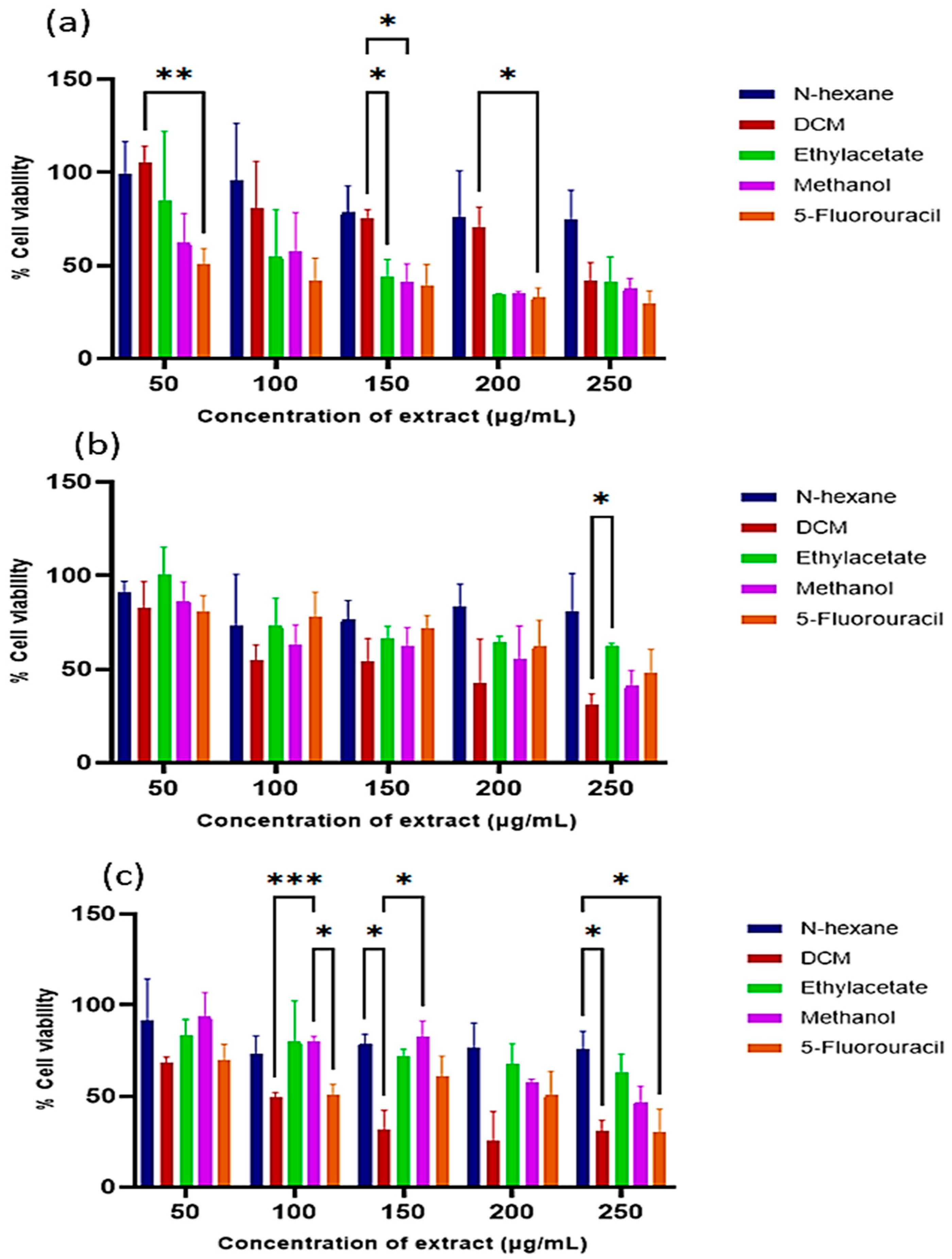
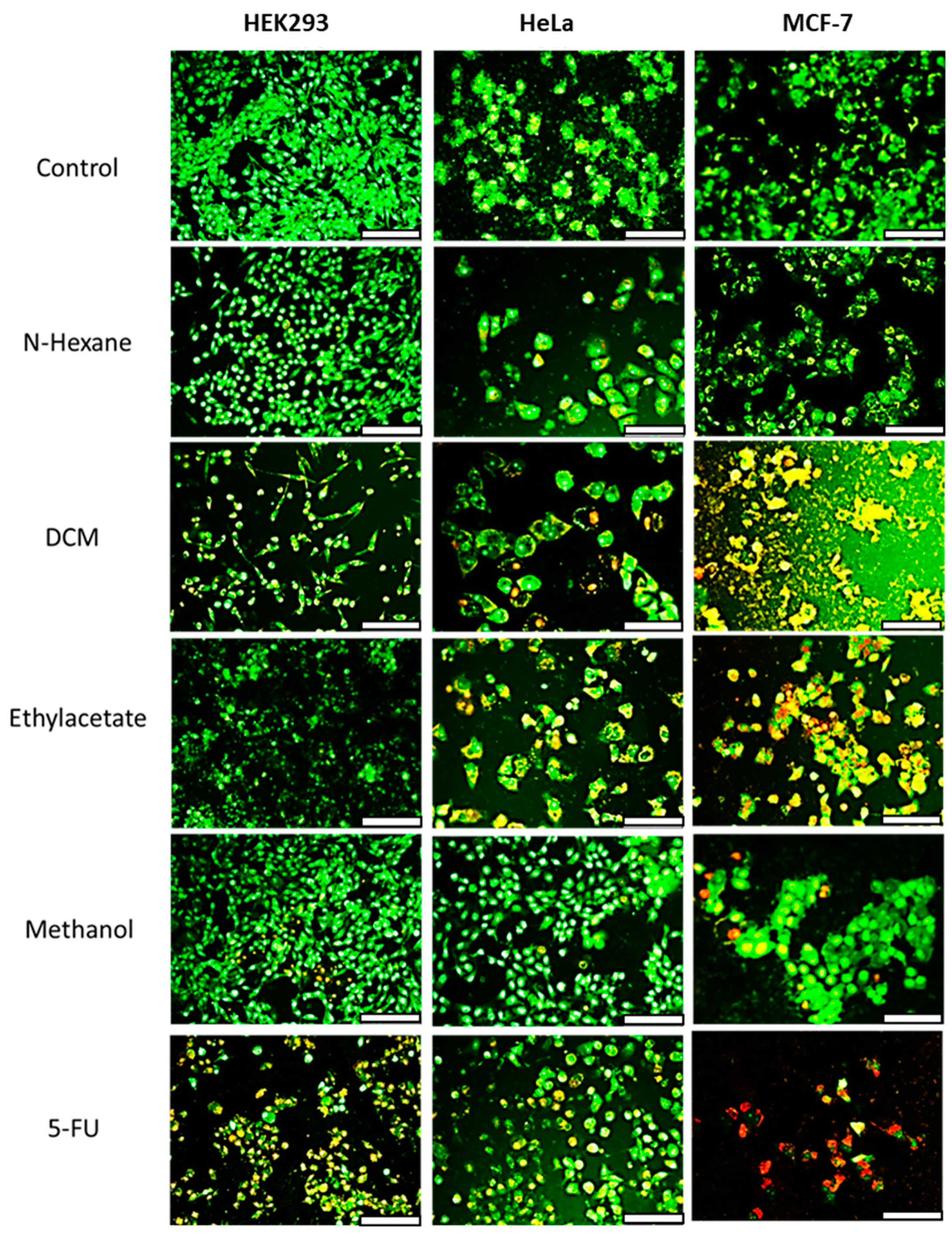
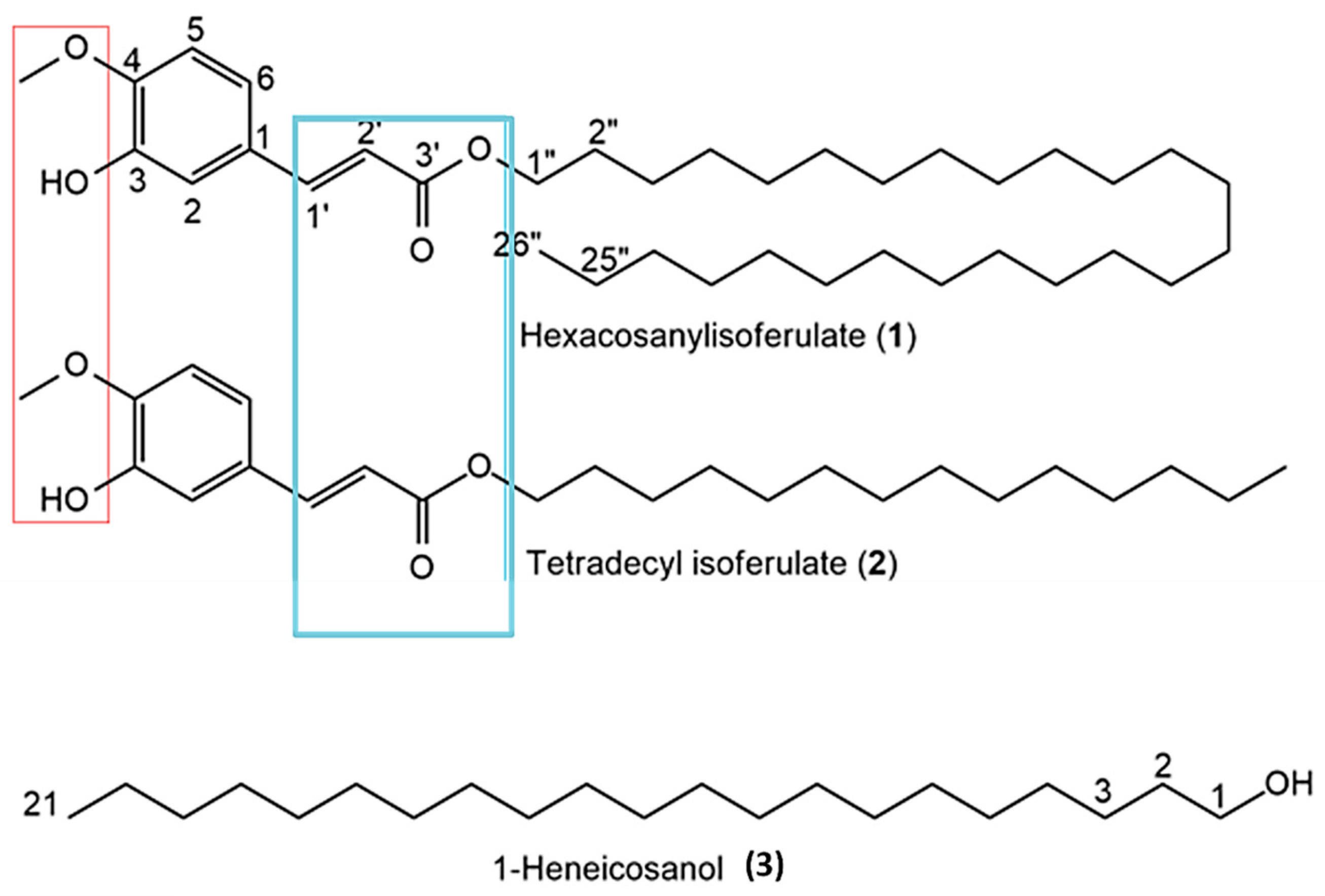
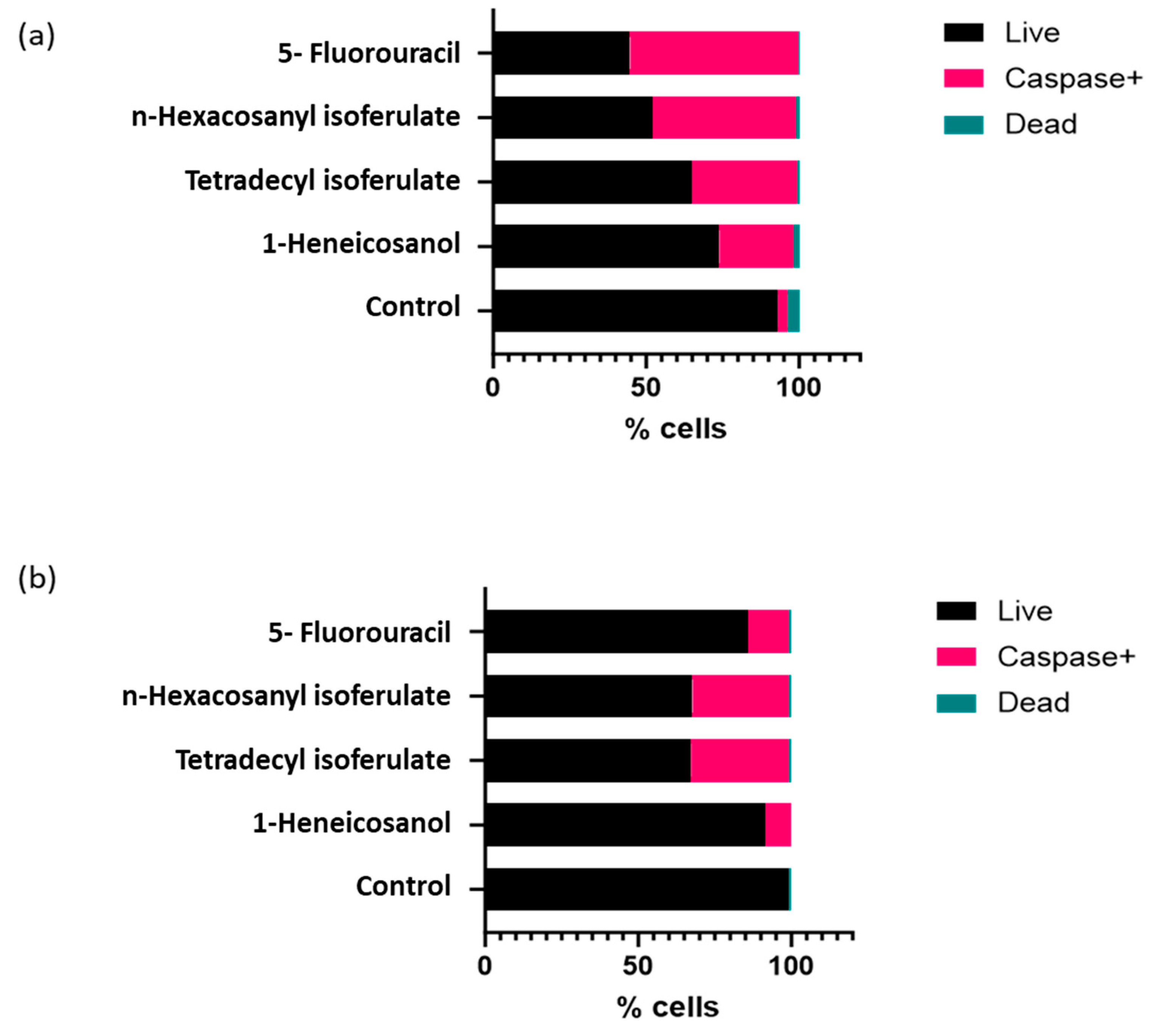
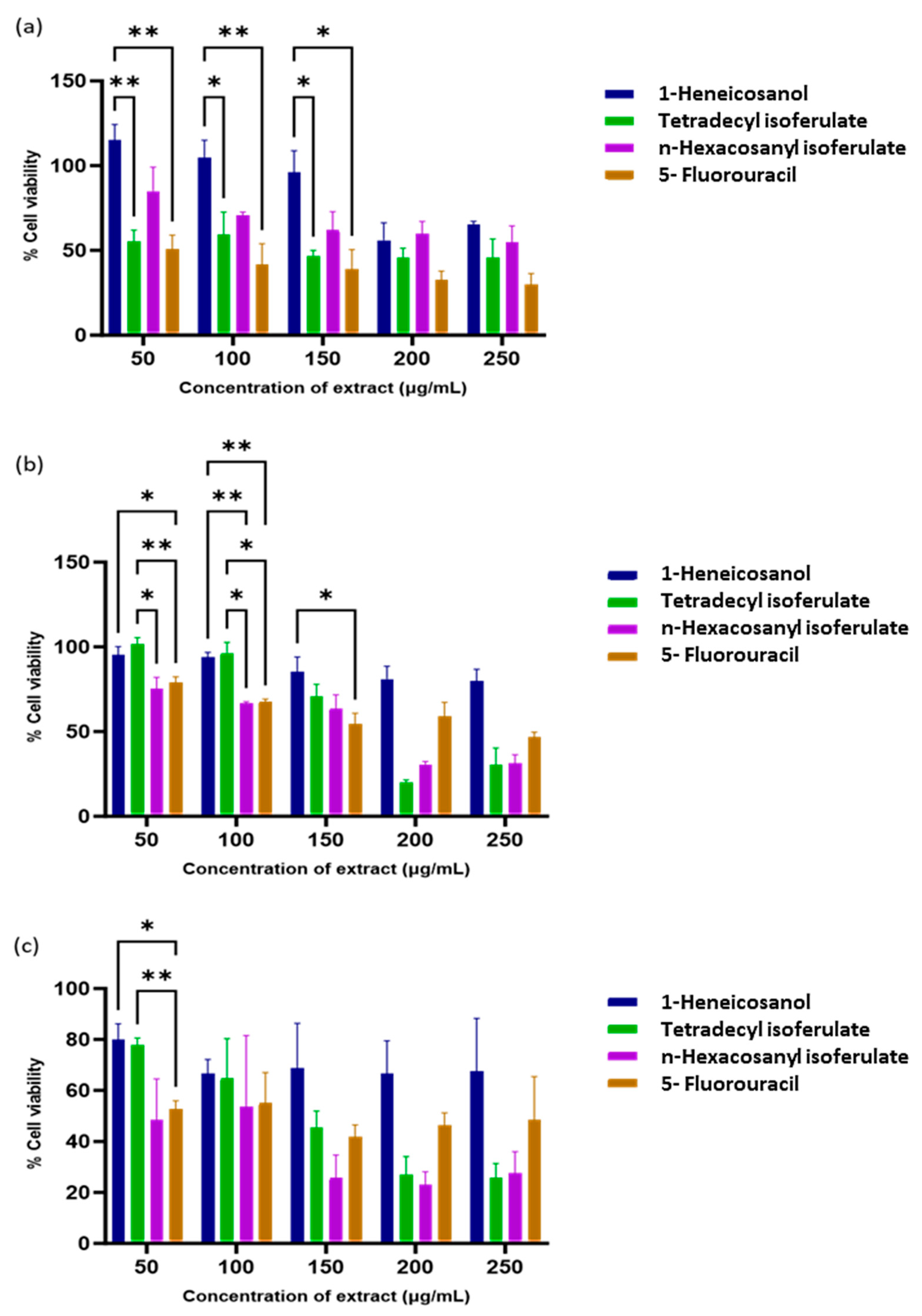
| Extracts/Standard/Drug | DPPH (µg/mL) | HEK293 (µg/mL) | MCF-7 (µg/mL) | HeLa (µg/mL) |
|---|---|---|---|---|
| Hexane | 84,990.83 | 996.55 | 4213.47 | 84,990.83 |
| DCM | 144.17 | 273.47 | 93.82 | 144.17 |
| Ethylacetate | 356.39 | 138.16 | 795.06 | 356.39 |
| Methanol | 208.18 | 108.45 | 295.61 | 208.18 |
| Ascorbic acid | 84.37 | - | - | - |
| 5-FU | - | 54.50 | 147.90 | 510.26 |
| Extracts/Standard | HEK293 (µg/mL) | MCF-7 (µg/mL) | HeLa (µg/mL) |
|---|---|---|---|
| 1-Heneicosanol | 371.5874 | 1979.46 | 4013.47 |
| Tetradecyl isoferulate | 140.6733 | 123.6174 | 169.80 |
| n-Hexacosanyl isoferulate | 316.1851 | 58.83905 | 146.63 |
Disclaimer/Publisher’s Note: The statements, opinions and data contained in all publications are solely those of the individual author(s) and contributor(s) and not of MDPI and/or the editor(s). MDPI and/or the editor(s) disclaim responsibility for any injury to people or property resulting from any ideas, methods, instructions or products referred to in the content. |
© 2025 by the authors. Licensee MDPI, Basel, Switzerland. This article is an open access article distributed under the terms and conditions of the Creative Commons Attribution (CC BY) license (https://creativecommons.org/licenses/by/4.0/).
Share and Cite
Olawale, F.; Bodede, O.; Ariatti, M.; Singh, M. Isolation, Characterization, Antioxidant and Anticancer Activities of Compounds from Erythrina caffra Stem Bark Extract. Antioxidants 2025, 14, 1035. https://doi.org/10.3390/antiox14091035
Olawale F, Bodede O, Ariatti M, Singh M. Isolation, Characterization, Antioxidant and Anticancer Activities of Compounds from Erythrina caffra Stem Bark Extract. Antioxidants. 2025; 14(9):1035. https://doi.org/10.3390/antiox14091035
Chicago/Turabian StyleOlawale, Femi, Olusola Bodede, Mario Ariatti, and Moganavelli Singh. 2025. "Isolation, Characterization, Antioxidant and Anticancer Activities of Compounds from Erythrina caffra Stem Bark Extract" Antioxidants 14, no. 9: 1035. https://doi.org/10.3390/antiox14091035
APA StyleOlawale, F., Bodede, O., Ariatti, M., & Singh, M. (2025). Isolation, Characterization, Antioxidant and Anticancer Activities of Compounds from Erythrina caffra Stem Bark Extract. Antioxidants, 14(9), 1035. https://doi.org/10.3390/antiox14091035








